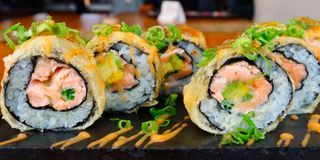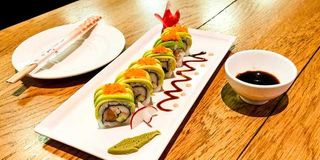Premium
Sushi lovers take YouTube lessons on chopstick use

Salmon Two Face Sushi dish pictured at Hero Restaurant in Nairobi on November 15, 2023.
The first time Esther Alma ate sushi, it was not a pleasant taste. Sushi is a Japanese raw seafood dish made of rice and seaweed and moulded into round-ish shapes with cucumber pieces sticking out.
“I had to eat more of it gradually to get used to it. That is how I ended up loving it, but I cannot eat a lot at once. It is a meal that you cannot have so much of,” she says.
Raw taste aside, the art of eating sushi with chopsticks was also a challenge.
“I travelled to Hong Kong for work and I was shocked. You have to eat everything using chopsticks. If you ask for a fork and knife, they look at you weirdly because they do not understand why you need them yet you have chopsticks. It was baptism by fire, but thank God for YouTube. Now, I eat all my sushi with chopsticks,” she says.
Ms Alma is among a growing number of Kenyans who have acquired a taste for sushi, in a country where a majority of diners prefer full or overcooked meals.
Among those whose palate has adapted to sushi is David Muriithi.
Mr Muriithi had his first sushi bite about 28 years ago.
“In 1995, my girlfriend (now, wife) took me out for a treat at Safari Park Hotel in Nairobi. This is where I first tasted tuna and salmon sushi,” he says.
Now, whenever he visits a new city, the first eating spot he looks for is a sushi restaurant.

Chef Caroline Kasena with Salmon Two Face Sushi dish at Hero Restaurant.
“I already loved seafood so the taste was not too foreign to me. I was hooked from then on. I love the way it tastes, especially accompanied by wasabi [a Japanese spice, which tastes like hot mustard]. There is also something very fresh and clean about eating raw fish,” he says.
Modifying sushi
But as Nairobi restaurants quietly build a tiny empire of raw fish, some have had to tamper down the sushi taste to accommodate Kenyans who would like to try it out as a YOLO [you only live once] meal or a date dish or a treat.
Restaurants have had to find ways to make sushi for the beginner who can eventually become advanced chopstick warriors.
At Hero Restaurant at Village Market in Nairobi, sushi is the main feature of their comic-inspired menu. As the name suggests, the superhero-themed restaurant has new recipes to introduce Kenyans to eating sushi.
“When Kenyans come to Hero to try sushi, they imagine being served raw oysters and rice. That is not the case. We have both raw and cooked sushi. We recommend the Tugulu roll, which has cooked prawns, and crab with mango and avocado. It is so juicy and sweet because of the mango and avocado. We also recommend this for children,” says Peter McCoy, manager at Hero Restaurant.
The chef who reinvented the sushi to accommodate the Kenyan palate is Caroline Kasena. Sushi is only prepared with seafood if one strictly follows Japanese traditions, but Ms Kasena decided to make it with pork instead.
“The teriyaki pork roll is one of my favourite dishes to prepare. It has glazed pork belly, bacon bits and crab meat. Most Kenyans order cooked sushi because of how we made it familiar to them by using different ingredients. Unlike most sushi places, we use local food such as sweet potatoes and coconut,” she tells BDLife.
For those who struggle eating sushi with chopsticks, Mr McCoy says, you have alternatives.

Tugulu Sushi roll served at Hero Restaurant in Nairobi on November 15, 2023.
“We encourage people to not struggle to use the chopsticks. They can use their hands or a fork and knife to enjoy their meal. We work extra hard to make Kenyans feel at home and comfortable when they eat sushi because 90 percent of our diners are foreigners,” he says.
Mr Muriithi recalls that it took him a month to master the art of using chopsticks.
Cost, eating
So if sushi is becoming the go-out date night meal or just a tryout dish, how should you eat it and how much will it cost you?
When you order the Tugulu rolls, for instance, you will be served a freshly prepared plate of five rolls, neatly arranged in a diagonal line with some dry ice for flare. This serving will cost you Sh1,800. A separate bowl is provided, which has soy sauce, pickled ginger and wasabi. These are used as dipping sauces.
If your palate is advanced enough, you could try the oyster and mango roll which has raw oysters and fresh crab or the Salmon Tataki Roll which has salmon that is only seared but not fully cooked. All the sushi rolls range between Sh1,200 to Sh2,400.
“Start with the soy sauce. It is your liquid base for the mixture. Soy sauce acts like salt. It balances the flavours. Next, add enough pickled ginger. It is supposed to help cleanse your palate as you taste different sushi. Lastly, add a little wasabi, which helps with indigestion. Stir it all together then taste it first to see if the mix is to your liking. Then dip your sushi roll and let it soak for a few seconds and eat it whole,” Mr McCoy says while carefully demonstrating his prowess in handling chopsticks.
He says the biggest fear that most diners have when they think of sushi is eating raw fish or seafood. This is why Wesley Mugambi has never imagined voluntarily ordering sushi.
“I cannot stand seafood. Then you tell me to eat it raw? I will puke my guts out. The smell of seafood alone gives me nausea,” he says.
Charles Mwaura says: “I always thought that I deny myself nice things. So I found myself ordering sushi as a treat and it came served with seaweed. I ate but didn’t like it, so I ordered a steak.”
“That is exactly what wasabi is there for,” Mr McCoy argues, “wasabi [a green substance] is only found in Japan, so restaurants like Hero import it from there.
“The first time I had it, a whole teaspoon which I was tricked to eat, it was horrible but adding just a little does the job,” he says.
Wasabi, or Japanese horseradish, is a vegetable that grows naturally along mountain river valleys in Japan.
Not authentic enough
But as restaurants modify sushi, some diners and chefs are sceptical about the taste: It is not the same as sushi served in Japan or prepared by a Japanese chef with 20 years of experience.

Maki Sushi rolls .
Kazu Onuki, executive chef at Sushi Mitsuki, the new sushi spot in Nairobi that boasts of serving 100 percent authentic Japanese sushi, says sushi culture is spreading in Africa but the wrong way.
The restaurant only seats 15 diners and a meal here ranges from Sh15,000 to Sh35,000.
“We felt sad that Japanese sushi culture is spreading in Kenya differently and that we cannot experience authentic sushi. Authentic sushi is served one-on-one at the counter and is only available within reach of a single chef. Therefore, seats are limited, and it is often the case that top sushi restaurants in Japan are booked up for a year or more,” reads the restaurant’s homepage.
The authenticity of sushi comes down to its fish that is shipped from one of the largest fish markets in the world, the Toyosu fish market, in Tokyo. The delicate fresh fish travels more than 10,000 kilometres so that Kenyans can have a real ‘raw’ Japanese sushi experience in Nairobi.
The search for authentic sushi taste has seen the likes of Mr Muriithi hop from one restaurant to another.
“I recently discovered Nigasu Sushi at Riverside Square in Nairobi, which had some pretty decent sushi options. I have yet to experience the exquisite Sushi Mitsuki restaurant at the Villa Rosa Kempinski Hotel, which boasts the best authentic sushi experience in Kenya at a not-so-cheap price,” he says.
Favourite in Kenya
As the trend grows, sushi die-hard fans like Mr Muriithi and Ms Alma are going far and wide to find the perfect sushi.
Ms Alma has made it a point to taste sushi whenever she travels abroad, citing a recent trip to Cape Town, South Africa, where she dined in the famous Japanese restaurant, Nobu. Mr Muriithi, on the other hand, has had sushi in 24 restaurants in Nairobi, Mombasa and Kisumu.
“My absolute favourite sushi restaurant in Kenya is split between Haru in Karen and Misono at the Greenhouse,” he says.





